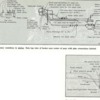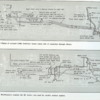I asked the same question several year back. I found it fascinating, these huge machines. At the Railroad Museum of PA, Strasburg, PA I spent some time with the M1b Pennsy. Took a lot of pictures, unfortunately, a lot has been dismantled, but there is a good bit still intact.
(1.) Some piping is electrical, still remnants of Radiophone and signal wiring on this locomotive. (at least one pipe/conduit here)
(2.) Most steam driven appliances (example: Stoker motor, and steam feed water pre-heat system motor), have a steam power in and steam exhaust, that in most cases is piped to the smoke box front of the locomotive.(Acount for two pipes here for each appliance)
(3.) Some appliances are air controlled, such as the sanders, Most air control piping appeared to be copper tubing installed under the boiler insulation jacket.
(4.) The duel air pump system showes the steam in from the Steam dome and then exhausted to the smoke box front. Some have said this is a Pennsy thing, most air pump steam drive systems were controlled from the steam valve manifold high in the backhead, cab area of the locomotive. Steam in, Steam exhaust, Air out to the Air tank system, and there is an air intake system also. (3 or 4 pipes)
(5.) Add to this, there are air brake lines for the locomotive and seperate air brake lines for the rest of the train. (2) pipes.
(6.) Passenger Service locomotives would have steam piping extending under the tender to the Passenger cars. Most likely, but I'm not sure, this piping would return to the locomotive or the tender.
(7.) There is also an automated lubrication system. Nathan oiler. ????
That's a start, gives you an idea how complex these machines were with very limited electrical.
Photo-bucket picture file M1a












